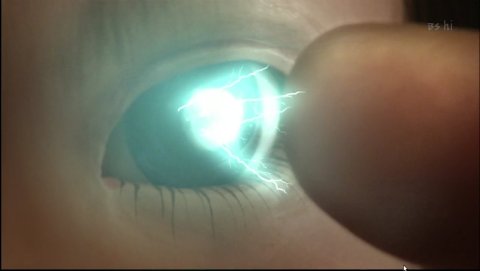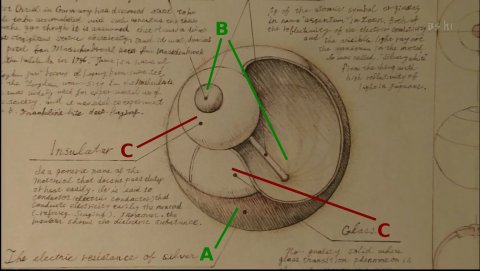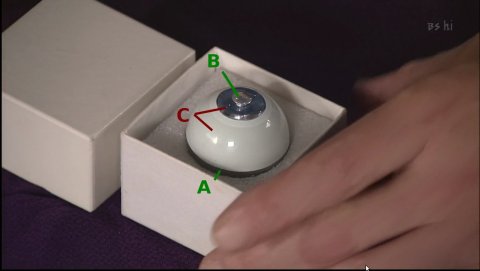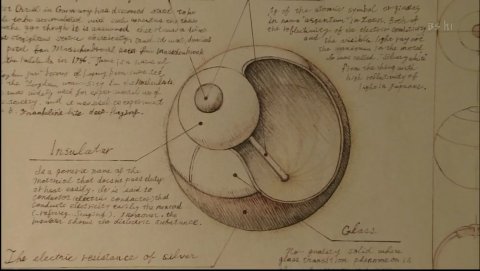You are currently browsing the tag archive for the ‘Electrons’ tag.
WARNING: SPOILERS AHEAD!!!
No, I’m afraid the similarly abbreviated quantum electrodynamics has yet to make an appearance on this show. But this episode does touch on static electricity, and since it glosses over the details, I’ll try to elucidate them here.
As explained in the episode, this creepy doll is responsible for death of the unsavory character lying lifeless at its feet.


This feat is accomplished when the dolls’ eyes (intentionally designed by museum’s curator for this lethal purpose) collected enough static electricity to deliver a jolting shock to the character, interfering with his pacemaker and giving him a heart attack.




Oh, the agony … and the super-cheap special effects.
OK, I’m not going to comment on how practically feasible this whole gimmick is. The concept is flaky, the explanation is sloppy, and the acting seems a bit inconsistent with the explanation, but I’ll try to explain what I think is going on anyway—on a theoretical level.
As an explanation, MIT genius kid Touma Sou says the eyes are Leyden jars, which the show tries to spectacularize by displaying a faux-historical shot of a manuscript page depicting the eye as a Leyden jar, surrounded by informative-looking scientific text …
… until you realize what it actually says:
[…] Christ in Garmany has discoveed static to be
[…] to be accumulated with such apperatus the there
[…] qgo though it is assuumed that it was a wire
[…] straightens statice electricicity, and it was devised
[…] petel van Musschenbrooke peter van Masschenbroek
[…] the Nethelands in 1746. There is a name of
[…] Leyden jar” becaus of haping þeen inovented
[…] the Leydun university in the Netherlands.
[…] was widely used for experimental use of
[…]lectricity, and it was used to experiment
[…] B. Franklin‘s kite deep-frying.Insulator
Is a generic name of the
material that doesn’t pass electy
or heat easily. It is said to
conductor (electric condactor) that
conducts electricity easily the noncond
(..referrig…singing). Moreover, the
insulator shows the dielectric substance.The electric resistance of silver
Ag of the atomic symbol originates
in name “argentum” in Latin. Both of
the reflectivity of the electric condutivity
and the visible light ray are
the maximum in the metal
it was called “silvery white”
from the thing with
high reflectivity of
light in Japanese.Glass
No- quality solid where
glass transition phenomenon is
[…]
LOL at the “Christ in Garmany”? And I’m not really sure what Ben Franklin’s culinary prowess with respect to the deep frying of kites has to do with anything, so let’s move on.
Here’s the diagram again, with the three labeled surfaces explicitly marked A, B, and C. I’ve also labeled a screenshot of one of the eyes. Note that the diagram labels the “Insulator” and the “Glass” separately, apparently confusing the generic concept of an insulator with an actual insulating material. In this case, the two surfaces are the same thing, and I’ve labeled both of them C. A is the exterior conducting surface, apparently made of silver, and B is the interior conducting surface.


As the show explains, people walking with rubber-soled shoes across the wool carpet pick up negative charge due to the triboelectric effect. In appropriate conditions (cold, dry air), there’s no conducting path for this excess charge to dissipate from the body, so it remains. For someone with negative charge to experience an electric shock, the negatively-charged electrons on their body have to travel to a region of more positive charge. The electric potential between the two regions is greatest when the respective charges are furthest apart, so the best conditions for such a shock would arise when someone is touching a positively-charged surface.
My best guess for how this positive charge gets there is that it is induced by rubbing the (silk?) cleaning cloth against the porcelain surface of the doll’s face. Since silk is higher up on the triboelectric series than unglazed porcelain, a positive charge collects on the cloth. If the cloth then comes in contact with the pupil of the eyeball, its positive charge is transferred to the interior, as both pupil and interior comprise conducting surface B, and the close proximity of conducting surfaces B and A induces a negative charge on A. This works if A is properly grounded, which I’ll assume is the case.
The attraction between A and B allows B to collect a large amount of positive charge, enough to result in a big spark, though this is limited by the capacitance of the eyeball, which is probably not that high due to the apparently limited surface area of the two conducting sheets.
So when negatively charged unsavory character touches positively charged pupil, electrons discharge and enter the eyeball, causing said unsavory character to experience a huge shock, flail dramatically, topple to the ground, and expire. C’est la vie.
That’s my take on it. The show’s explanation, as far as I can tell, mentions negative charge on both bodies without discussing positive charge at all, which is necessary for the discharge to occur. In addition, Sou’s rubbing of the doll with a cloth clearly misses the pupil, which leaves the viewer wondering how that could have effectively transferred any positive charge into the eyeball at all.
I’m afraid that on a technical level, this episode leaves me much more disappointed than Episode 1, unless I totally missed what’s going on (and please enlighten me if that’s the case!). Oh, well. Let’s hope there’s more awesomeness to come….
EDIT: Did you think I was going to let you go without some physics equations? Of course not!
Let’s figure out how much energy is transferred when someone gets a shock from touching the doll’s eyeball. Since we’re not given all the information, let’s make educated guesses. Suppose the outer conducting shell has a radius of 2.5 cm, and it’s separated from the inner conducting shell by an insulating layer of 1 mm thickness. The diagram says it’s made of glass, so let’s give it a dielectric constant of 5. Furthermore, we’ll idealize the whole thing as a spherical capacitor, so as not to worry about those bothersome non-symmetric electric fields.
We can now compute the capacitance of the eyeball, replacing the glass with vacuum temporarily. If there is a charge of Q on the inner shell, the electric field at radius r outside between the two shells is
.
Integrating this over r between the two shells, we can compute the electric potential difference between them:
Since capacitance is charge divided by voltage, the capacitance is
The energy of a discharge depends on the charge Q transferred:
Assume a typical charge of 1 microcoulomb is transferred. Then, plugging in our assumed values (r1 = 2.4 cm, r2 = 2.5 cm, Q = 1e-6 J, ε = 5ε0), we have about 0.001498 joules, which is the amount of energy needed to move a one-kilogram block a height of 0.1527 millimeters.



Recent Comments